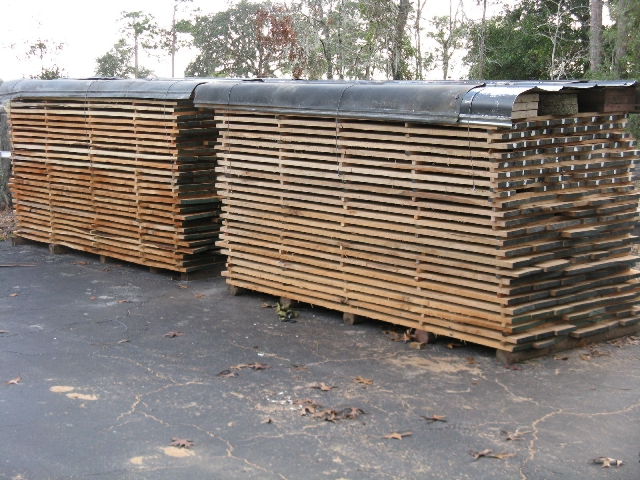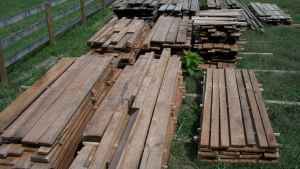Buying Lumber at Auction
Tips on assessing the quality of air-dried hardwood up for sale at a small auction. October 3, 2009
Question
What should I lookout for when purchasing from someone selling lumber not at the retail level? An ad I viewed claims the lumber is air dried. Will this be sufficient for my projects such as a blanket chest?
Forum Responses
(Sawing and Drying Forum)
From contributor J:
Look at how it's been stored, for one thing. Such wood is often stored in unheated buildings, in which case the MC will be higher than is appropriate for indoor/furniture purposes. You can finish drying it, but by that point it might not seem like such a bargain. Even if you do put it in proper storage and wait for the MC to drop, this wood may be more prone to move, and thus less forgiving of improper construction styles, than KD wood would be. I'd also keep an eye out for insect damage.
From the original questioner:
Thanks contributor J. Just the info I was looking for. I definitely do not have room or time to store any lumber. My workshop is my 10'x12' shed. I might save myself a trip and not go. I’m still waiting for reply back from seller to make a final decision.
From contributor L:
I have to disagree on the more prone to move statement. Once it is dry to a suitable moisture content it is dry whether in a kiln or air dried. Air dried will not have some of the problems sometimes associated with kiln dried, such as case hardened. I've built with air dried for years.
From contributor R:
I agree with contributor L. You can build with air dried and never have a problem. Most likely the MC is going to be at about 13% maybe a little under. If it was dried out with doors and a roof over it to keep direct sun and rain off of it, it will have a value as any other. One other thing - check to see if it was end coated, or you may have to trim 3" or more from the ends.

Click here for higher quality, full size image
From the original questioner:
Thanks all. I contacted the seller for more information on the protection from the elements. It was stated that the wood was stacked, air dried, and covered with a tarp. I don't know if covering with a tarp is much different than a roof covering the lumber. Thanks contributor R for the end coating tip.
From contributor V:
I attend quite a few auctions and sales and even sell much of my lumber at farm auctions. One thing about an auction or clearance sale is that often time the buyer sets the price. If you feel the lumber is suitable for your purpose and can get a good deal on it, fine.
I have built a white oak window seat with frame and panel construction for my home years ago and it has never had any joints open up, twist, or bow. I would never build a project for anyone else without kiln dried lumber. Sometimes "sale lumber" is pieces that may not be of the highest quality, they may be a little too thin to meet 4/4 specs, or have one or more of the obvious common problems of bow, crook, twist, or cup. I would go and check it out. The thing that concerns me most is the fact that you mentioned the wood was covered with a tarp. Check for any signs of mold.
From Gene Wengert, forum technical advisor:
Air-dried lumber can have powderpost beetles. With the recent hurricanes, PPB’s are more common than ever. Kiln drying above 130 degrees F eliminates them and their eggs. With softwoods, the resin will flow at room temperature unless the wood has been heated to 160 degrees F or hotter (in most cases.)
Wood will shrink and swell about 1% in size for each 4% MC change. (AD or KD does not matter; the wood moves the same amount for each 1% MC change.) With air drying, you can achieve 13% to 16% MC in most cases, if air dried for along time. (Of course, long air drying will often lead to stain and checking.) The MC in use for flooring, furniture and cabinets is about 7% MC. Using air dried lumber without further drying in a heated shop or kiln or other location will mean that the wood will move considerably as it goes from 14% MC to 7% MC in use, especially oak and other higher density species.
So, the bottom line is that air dried wood can be used, but it must be at or near 7% MC to avoid shrinkage. Due to the high risk of PPB’s today, I suggest avoiding lumber that has not been heated above 130 F, at this time. (You cannot tell if the lumber has PPB’s until the air is warmed and then the insects begin to exit the lumber with this warmth.)
From the original questioner:
Great information. I am located in Northern VA so the humidity can be high. The seller stated the wood had been drying for 11 months. I am going there mainly for black walnut at $2.50 a BF all thicknesses. I can't pass up that price. I may check out some cedar or cherry for other future projects.

From Gene Wengert, forum technical advisor:
You could probably rent a small trailer and heat the wood to 130 F in that "kiln" to kill any PPB’s.

